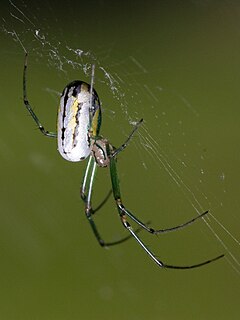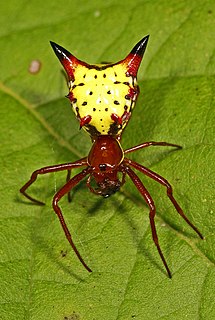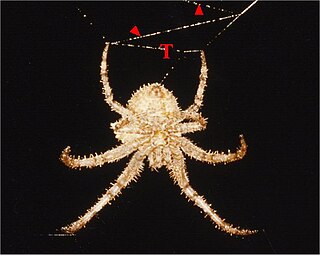
Orb-weaver spiders are members of the spider family Araneidae. They are the most common group of builders of spiral wheel-shaped webs often found in gardens, fields, and forests. The English word orb can mean "circular", hence the English name of the group. Araneids have eight similar eyes, hairy or spiny legs, and no stridulating organs.

Eriophora is a genus of orb-weaver spiders first described by Eugène Simon in 1895. It occurs in the Americas, Australasia, and Africa. The name is derived from Ancient Greek roots, and means "wool bearing".

Ordgarius is a genus of orb-weaver spiders first described by Eugen von Keyserling in 1886. Adult females of the genus are bolas spiders, capturing their prey with one or more sticky drops at the end of a single line of silk rather than in a web. Males and juvenile females capture their prey directly with their legs.

Leucauge is a spider genus of long-jawed orb weavers, with over 160 species and fully pantropical distribution.

Micrathena, known as spiny orbweavers, is a genus of orb-weaver spiders first described by Carl Jakob Sundevall in 1833. Micrathena contains more than a hundred species, most of them Neotropical woodland-dwelling species. The name is derived from the Greek "micro", meaning "small", and the goddess Athena.
Bertrana is a genus of Central and South American orb-weaver spiders first described by Eugen von Keyserling in 1884. It includes some of the smallest known araneid orb-weavers. Bertrana striolata females are 4.5 mm long or less. The eight eyes are in two rows. The abdomen is white on top and on the sides, with multiple hieroglyphic-like lines and bars of many different shapes and length. In females, these are red, in males, black.

Kaira, sometimes called frilled orbweavers, is a mostly neotropical genus of orb-weaver spiders first described by O. Pickard-Cambridge in 1889. It includes sixteen described species that occur from South America up to the southern and eastern USA. It is presumably related to Aculepeira, Amazonepeira and Metepeira.

Metleucauge is a genus of long-jawed orb-weavers that was first described by Herbert Walter Levi in 1980.
Amazonepeira is a genus of South American orb-weaver spiders first described by Herbert Walter Levi in 1989.
Dubiepeira is a genus of South American orb-weaver spiders first described by Herbert Walter Levi in 1991.
Galaporella is a genus of South American orb-weaver spiders containing the single species, Galaporella thaleri. It was first described by Herbert Walter Levi in 2009, and has only been found in Ecuador.
Hingstepeira is a genus of South American orb-weaver spiders first described by Herbert Walter Levi in 1995.
Kapogea is a genus of orb-weaver spiders first described by Herbert Walter Levi in 1997.
Manogea is a genus of Central and South American orb-weaver spiders first described by Herbert Walter Levi in 1997. As of April 2019 it contains only three species.
Neogea is a genus of orb-weaver spiders first described by Herbert Walter Levi in 1983. As of April 2019 it contains only three species.
Nicolepeira is a genus of South American orb-weaver spiders first described by Herbert Walter Levi in 2001. As of April 2019 it contains only three species, all found in Chile.
Rubrepeira is a genus of orb-weaver spiders containing the single species, Rubrepeira rubronigra. It was first described by Herbert Walter Levi in 1992, found from Mexico to Brazil.
Spinepeira is a genus of South American orb-weaver spiders containing the single species, Spinepeira schlingeri. It was first described by Herbert Walter Levi in 1995, and has only been found in Peru.
Tatepeira is a genus of Central and South American orb-weaver spiders first described by Herbert Walter Levi in 1995.
Gasteracantha flava is a species of spider described in 1849 from Chile. The spider's abdomen bears 14 spines and is yellow in color with brown or black sigilla and a strongly wrinkled ventral side. The World Spider Catalog currently treats this taxon as a spiny orb-weaver spider in the genus Gasteracantha. In 1849, H. Nicolet included it in the genus Gasteracantha along with 18 other species he described from Chile. Nicolet described G. flava as being closely allied to another species described at the same time, Gasteracantha spissa, which had the same number and shape of spines and was very similar. Subsequent authors refined Nicolet's species, and in a 1996 publication Herbert Levi wrote, "All Nicolet's species seem to belong in Phoroncidia (Theridiidae)." Levi transferred the 14-spined taxon spissa, described by Nicolet as very similar to G. flava, to the genus Phoroncidia, creating the new combination Phoroncidia spissa. However, Levi did not explicitly address G. flava, so it remains in Gasteracantha as of November 2019, though its purported sister species now belongs to Phoroncidia and no other Gasteracantha species has more than six spines.






